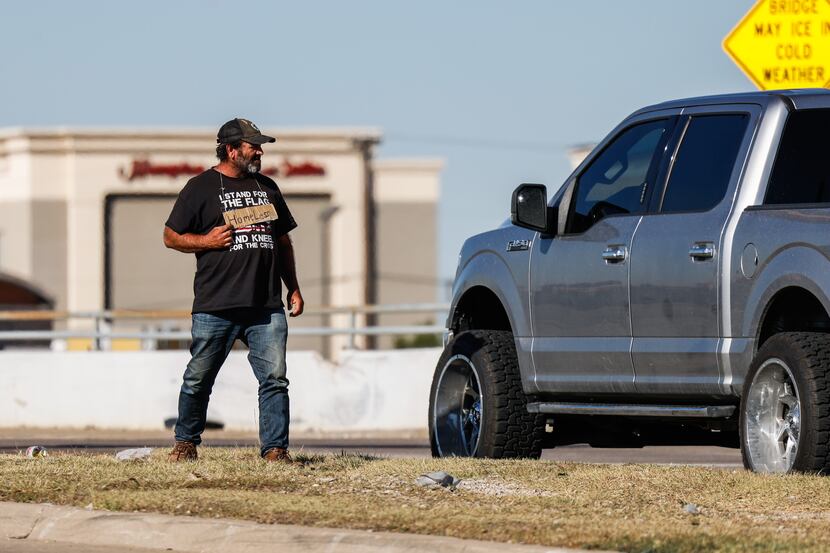A new Dallas law banning people from road medians or risk a fine up to $500 opens the city up to a lawsuit that could cost taxpayers, legal experts say.
The restriction bans pedestrians from standing or walking on roadway medians less than 6 feet wide, in the middle of streets without medians and in clear zones like bike lanes and road shoulders. It exempts permitted workers, as well as pedestrians directly crossing the street, giving or receiving emergency aid, or on the median while following police instructions.
City officials since at least last year have publicly presented the restriction as a way to address complaints stemming from people panhandling while on the dividing strip or in the middle of streets where there is no median. It was rebranded in the months leading up to the City Council’s Oct. 26 approval as being driven by pedestrian traffic safety concerns.
But at least two federal appeals courts since 2015 have ruled that similar ordinances -- one passed in Portland, Maine in 2013, the other in Oklahoma City in 2015 -- are unconstitutional. A U.S. District Judge in Oklahoma ordered Oklahoma City in 2021 to pay around $1 million in legal fees after it was found the city’s ordinance violated free speech.
“The Dallas ordinance fails to recognize medians as public spaces for First Amendment activity,” said Savannah Kumar, an attorney with the American Civil Liberties Union of Texas. “The ordinance is overly broad, and courts have repeatedly found that you can’t just arbitrarily ban all activity in public spaces like medians.”
Dallas City Attorney Chris Caso declined comment on the threat of possible legal challenges to the new city ordinance.
“This ordinance raises constitutional concerns, and the ACLU of Texas is concerned about any effort to criminalize poverty, especially using unconstitutional means,” Kumar said, noting that being on the median while engaged in protest would likely be among the new Dallas restrictions. “We are exploring our options.”
The lawsuit in the Oklahoma City case included plaintiffs identified as homeless residents, joggers, a journalist and a community activist who all cited their constitutional rights were being infringed on. The Supreme Court has previously ruled that panhandling is constitutionally protected under the First Amendment.
Joseph Thai, an attorney who worked with the ACLU of Oklahoma to challenge the Oklahoma City ordinance, said one main similarity he sees with the restrictions in in Oklahoma City and Dallas is that officials haven’t provided enough evidence of a pedestrian safety problem on medians as justification.
“If data shows there is a median or particular medians where people are hit while on or stepping off, then I think the city could probably just address those areas rather than an indiscriminate ban,” said Thai, a constitutional law professor at the University of Oklahoma. “And as we’ve seen, these city laws are not free. Just like free speech isn’t free because there is a cost to defending it.”
Thai said he and other attorneys argued that there were more cases of people struck by lightning in Oklahoma City than hit by vehicles while standing or walking on medians.
“In Oklahoma City at the time the number of people we found that were struck by cars while standing on medians was zero,” Thai said.
Before Dallas council members voted to approve the ordinance last month, Dallas Police Assistant Chief Michael Igo said he knew of only one case this year where evidence showed a pedestrian was struck and killed by a vehicle after stepping off a road median. He said officers at that point had responded to 45 traffic-related pedestrian deaths this year.
“We don’t have supporting information nor is it documented anywhere in our information that any driver inattention or distraction was caused by subjects on the medians,” Igo told council members during the Oct. 26 meeting. He said the department would support any city traffic or rule changes to help people more safely cross roadways.
Police Chief Eddie García said median enforcement will be a low priority for officers. Interim City Marshal David Pughes said he wasn’t planning to have marshals routinely patrol medians around the city.
He told The Dallas Morning News on Monday that no one has been cited by marshals since the City Council approved the restrictions.

Median ban concern
The median ban has drawn concerns that it could disproportionately impact Dallas’ homeless population, putting the city’s most vulnerable residents at risk of being further disadvantaged.
Because of the wide range of people who could use medians to stand or walk on for a prolonged period of time, like panhandlers, protestors, or people advertising a nearby fundraiser, a legal challenge can come from virtually anyone, Kumar said.
Council member Adam Bazaldua, who cast the lone vote against the median ban in October, called it “absurd” and “absolutely despicable.” He described the ordinance as an effort by the city to enforce poverty, criminalize homelessness and panhandling.
“It is extremely disingenuous to stand here and tell us that this is about public safety. This is about NIMBYism,” Bazaldua said. He later cited the Oklahoma City case as a reason to vote against the ordinance.
But the ordinance comes amid a push by the city to increase pedestrian safety. A city audit in May found Dallas’ transportation department didn’t have any written procedures or plans to decrease the number of pedestrians hit in traffic.
The City Council the next month approved a Vision Zero plan with 40 things the city can do to curb traffic deaths. The plan is meant to hit a goal of no traffic deaths in Dallas by 2030.
National data shows Dallas roads are among the deadliest for pedestrians and drivers in the U.S. Dallas had the highest rate of pedestrian deaths among the 20 largest cities in the U.S., with 4.91 pedestrian deaths per 100,000 people in 2020, according to the National Highway Traffic Safety Administration.
There are legitimate safety concerns to both drivers and pedestrians on medians, city officials say. Some people who panhandle are aggressive with drivers. And it’s not uncommon in some parts of the city to see people walk into traffic or stand in the middle of the road where there is no divider to get the attention of motorists.
“This item is about public safety,” said council member Cara Mendelsohn during the Oct. 26 meeting. “The idea of this is to protect people on the median. We’re not trying to deter people from having a walkable city, but when you have a six-lane road, it is dangerous for every pedestrian to cross.”
Appeals Court rulings
But just claiming a public safety risk isn’t valid enough, according to two federal appeal courts.
When the City Council in Portland, Maine passed its ordinance banning people from medians except when crossing from one side of the street to the other, it didn’t address specific features of the median, such as size. The police chief a year earlier described an increase in panhandling on city road medians as a “public safety emergency.”
The city was later sued and accused of violating the First Amendment. The district court ruled against the city, and the 1st Circuit Court of Appeals upheld the lower court’s ruling in 2015.
“We conclude that the ordinance does [violate the First Amendment] because it indiscriminately bans virtually all expressive activity in all of the city’s median strips and thus is not narrowly tailored to serve the city’s interest in protecting public safety,” the appeals court opinion said.
When Oklahoma City approved its ordinance, it banned people from sitting or standing on medians less than 30 feet wide and less than 200 feet away from any intersection. People who violated the ordinance could be issued a $100 fine.
The city was sued, and an Oklahoma City federal court judge sided with the city in 2018. But the 10th Circuit Court of Appeals disagreed two years later and found the ordinance unconstitutional. The U.S. Supreme Court in 2021 rejected the city’s request to review the case.
The Supreme Court’s decision not to weigh in could mean a legal challenge to Dallas’ ordinance isn’t a slam dunk to be overturned, according to Brian Owsley, an associate professor at the University of North Texas at Dallas’ College of Law.
If Dallas’ ordinance were reviewed by the 5th Circuit Court of Appeals, which covers Texas, judges on that panel could rule differently.
The 1st Circuit Court of Appeals has jurisdiction in Maine, Massachusetts, New Hampshire, Rhode Island and Puerto Rico. The 10th Circuit Court of Appeals covers Oklahoma, Kansas, New Mexico, Colorado, Wyoming, Utah and parts of Yellowstone National Park in Montana and Idaho.
“Any judges in the 5th Circuit may be persuaded by a prior ruling in another circuit, but they aren’t bound by it,” Owsley said. “The 5th Circuit Court of Appeals is one of the most conservative federal appeal courts in the nation, so it’s conceivable that they could rule in a different way.”
Owsley said he agrees that medians are public spaces and believes Dallas’ ordinance “makes the city susceptible to the same thing that happened in Oklahoma City.”
“There is a real safety concern. I know because I live in Dallas and I see it,” Owsley said. “But at the same time, the ordinance is a risk. As a resident of Dallas, I wouldn’t want the city to needlessly incur that type of expense on behalf of us as taxpayers.”

